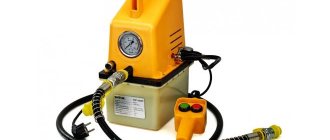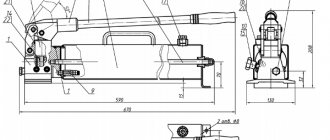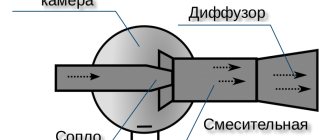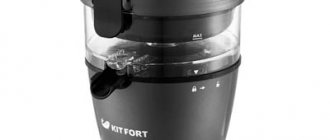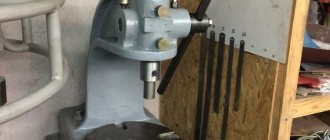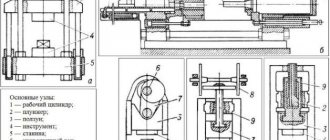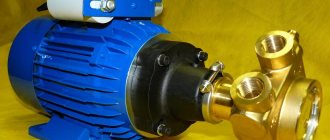Without exaggeration, the hydraulic press is one of the 100 greatest inventions of mankind. The appearance of such a machine was facilitated by Pascal’s law, which was formulated back in 1653. The first such device was patented by the English inventor, one of the founders of hydraulic engineering, Joseph Bramah, in 1795.
At first, the hydraulic press was used to lift heavy loads and obtain natural oils and juices, as well as form hay bales. Over time, the design of hydraulic presses has changed and modernized. Since 1820, the unit began to be used in the metalworking industry for pressing pipes. 55 years later, a stamp and a movable traverse appeared in the design, which contributed to the introduction of the technology into the military industry.
Thanks to the saving of metal, simplicity of design, speed of production and optimal performance, the press is widely used in the production of automobiles, marine vessels, aviation and agricultural equipment.
Varieties and characteristics
Main characteristics of a hydraulic press (parameters of each model are shown in the drawing):
- compression force (tons);
- handle force (Newtons);
- operating speed (millimeters per second);
- working stroke (centimeters);
- oil pressure in the hydraulic drive (Megapascal);
- drive power (kilowatts);
- dimensions and weight (millimeters and kilograms).
This range of parameters defines two types of drives:
- pump drive – does not use the principle of energy storage;
- pump-flywheel and pump-accumulator drives - use energy accumulation during periods between working strokes.
The service station uses different types of hydraulic presses: tabletop, vertical, electrohydraulic and pneumohydraulic (capable of developing a force of up to 100 tons).
According to the method of functioning, hydraulic presses are divided into two groups:
- automatic;
- manual.
Manufacturers make units with closed and open frames for working with elements of non-standard shapes. Based on the dimensions, there are desktop and floor-standing models. Depending on the bed, there are 2 types of presses: rack-mount and column-mounted. By type, two categories of devices can be distinguished: universal and specialized (special purpose).
Types of hydraulic presses
- Centrifugal presses are used for stamping seats and removing bearings, as well as for other assembly, repair and high-pressure production work.
- Assembly presses use high pressure to hold or assemble parts.
- C-frame presses are streamlined in size, have a press shape that resembles the letter “C,” and typically consist of a single press.
- Compression molding presses use two plates that are pushed together to compress the material in a mold.
- Forging presses are machines that force metal blocks into the shape of a product using a mold, extreme force and pressure, and sometimes heat.
- H-frame presses , sometimes called four-column presses, are shaped like the letter "H" and can often handle more than one application at a time.
- Hydraulic presses are industrial machines that use fluid pressure to apply force to an object.
- Lab presses are smaller, disposable presses used primarily in research laboratories and other short and test run situations.
- Lamination presses
- LIM presses are presses that work with plastics created through the injection molding process.
- Mechanical presses are used to cut, stamp, shape, or assemble materials using tools or dies attached to guides or dies.
- Platinum presses are large industrial hydraulic presses that use two large heated steel plates to crush, compact, shape and form a variety of products.
- Pneumatic presses use energy transfer in the form of a stream of compressed air to control their movements. Some typical applications are cutting, stamping, bending and forming.
- Power presses are machines that use tools and dies to cut, stamp, and shape metals.
- Press brakes are manual, mechanical or hydraulic presses that cold work sheet metal into bent or bent shapes. Here you will find a press break calculator.
- Stamping presses are devices that use stamping dies.
- Proper presses apply pressure to the metal to straighten it.
- Tablet presses are used to compress powdered materials into tablets or briquettes.
- Transfer presses are hydraulic presses that automatically move parts from one stamping process to another using feed rod fingers.
- Vacuum presses are hydraulically driven industrial systems that use air pressure to provide the necessary force and air removal required for lamination.
Application and practical features of work
The wide range of power and design solutions of hydraulic presses allows them to be used for a variety of tasks: stamping, trimming, flanging, embossing, pressing, stitching, calibrating, bending, forging and even lamination.
Areas of use:
- industrial production;
- waste disposal (horizontal installations);
- repair of vehicles and special equipment;
- locksmith work.
Using such equipment, you can work with pipes and metal profiles, plastic and ceramic products, carbon and carbon-graphite electrodes, as well as produce rubber parts, cables, electrical insulating materials, various finishing and building boards and much more.
Features of various models:
- glycerin pressure gauges are characterized by increased accuracy, durability, vibration suppression and a wide measurement range;
- the winch mechanism is indispensable for adjusting the working surface;
- automatic rod return function significantly improves productivity;
- the safety valve will prevent excess pressure;
- chrome plated rod eliminates corrosion processes;
- modern units are equipped with progressive CNC.
In addition, the designs do not include various modules that protect against overloads, which has a positive effect on the price of pressing equipment. It is also noteworthy that the position of the moving table has no effect on the pressure value.
Hydraulic presses
A hydraulic press is a pressure pressing machine that uses hydraulic pressure, or fluid pressure, through a cylinder to apply force to an object.
Hydraulic presses are based on Pascal's principle, according to which pressure in a closed system will act with equal force in all areas.
As the most common and most efficient type of industrial press, hydraulic presses have high lifting or compressive force that cannot be achieved with pneumatic or mechanical presses.
Application of hydraulic presses
Hydraulic presses are manufactured to enable manufacturers to stamp metal material onto a variety of finished parts. They can also perform other metal forming processes such as bonding, forging, stamping, cutting, forming, deep drawing and blanking.
Some of the industries that rely most on hydraulic press services include: Automotive, Packaging, Home Appliances (e.g. Microwave Oven Parts, Dishwashers, Refrigerators, etc.), Ceramics, Aerospace, Military and Defense, Manufacturing food and beverages, cellulose, etc.
Some of the most common applications for hydraulic presses include making beverage cans and making auto parts.
History of the hydraulic press
The hydraulic press was invented in England in 1795 by Joseph Bramach, who became involved in the study of liquids after developing the flush toilet. For this reason, hydraulic presses are sometimes called Brahm presses. He based his invention on a concept known as Pascal's principle, or Pascal's law, which maintains constant pressure throughout a closed system.
Brahma invented the hydraulic press at a time when there were very few of them. Thus, he paved the way for hydraulic engineers after him. Those who followed this path have since invented dozens of variations of the original Brahma model.
How does a hydraulic press work?
A hydraulic press begins to operate when hydraulic fluid is forced into a small double-acting cylinder (slave cylinder) using a hydraulic pump or lever.
Inside this hydraulic cylinder there is a sliding piston that acts on the fluid as a compressive force. It forces it through a pipe into a larger cylinder (the master cylinder), where the fluid is compressed again by a larger piston.
larger piston forces fluid back into the smaller cylinder. As the fluid moves back and forth, the pressure builds until it becomes so great that it can contact and press against the support, backing plate, or die. When it does this, it deforms the material into the desired shape of the product.
To stop the overload, once the set pressure is reached, the fluid then activates a valve which activates pressure reversal. With this press design, there is no need for a complex guide system, since the die tends to guide the press itself.
Advantages
Among the advantages of hydraulic presses, the main ones are:
- significant gain;
- the ability to implement different technological processes;
- high design reliability and safety;
- ease of work under a given mode;
- ease of control and low noise level;
- the ability to connect any hydraulic equipment to the drive (buckets, jackhammers, grippers, circular saws);
- speed and practicality.
Before purchasing such equipment, you should pay attention to the material of the frame structure, the quality of the seams, the presence of a return piston, the serviceability and reliability of the pressure gauge and hydraulic system, and also check the possibility of adjusting the height of the working area.
How does a hydraulic press work?
The principle of a hydraulic press is based on the law of communicating vessels. For example, there are 2 connected containers of different sizes. By pouring the liquid there, it will be evenly distributed. If the state of rest is disturbed and the pressure in the smaller vessel is increased, then in the larger vessel the applied force will increase in proportion to the difference in size. The device obeys the rule: the gain in strength is equal to the loss in distance.
Read also: Which wood burning device is better?
Blaise Pascal came up with the idea of how the hydraulic press works, but called it a “machine for increasing strength.” Previously, the benefits from such a machine seemed negligible, but now engineers used Pascal's developments to make the work easier.
Design features of systems based on hydraulic cylinders
Technical systems, the functioning of which is ensured by a hydraulic cylinder, consist of the following elements:
- hydraulic cylinder;
- hydraulic motor;
- pump;
- emergency valve;
- container containing the working fluid.
Hydraulic diagram of the press (simplified)
The hydraulic cylinder itself consists of the following structural elements:
- housings;
- a piston rigidly connected to the rod;
- block cover, which is equipped with hydraulic equipment that allows you to control the operating parameters of the device.
The performance of a hydraulic cylinder-based system depends on a number of parameters:
- pressure level of the working fluid pumped by the pump;
- diameter of the piston working surface;
- volume of the working chamber of the device.
Hydraulic cylinders with flange mounting on the head side
The characteristics of the working fluid used are of great importance for the efficiency of the hydraulic cylinder:
- chemical composition and density;
- temperature limits at which the working fluid retains its original qualities;
- tendency to develop oxidative processes.
An important quality of the working fluid for a hydraulic cylinder, which you should pay attention to when choosing it, is the ability to retain its original characteristics when in contact with water (water can enter the hydraulic system from the outside).
As practice shows, in 70% of cases of hydraulic cylinder failure or incorrect operation, low-quality working fluid is used for the device. The result is increased wear of individual elements of the hydraulic system, the development of corrosion on the surfaces of metal elements, an increase in oil viscosity, its clogging with dust or dirt, and the appearance of water and air in its composition. Naturally, all such situations, the occurrence and development of which should be avoided, negatively affect the performance of the hydraulic system itself and its elements.

